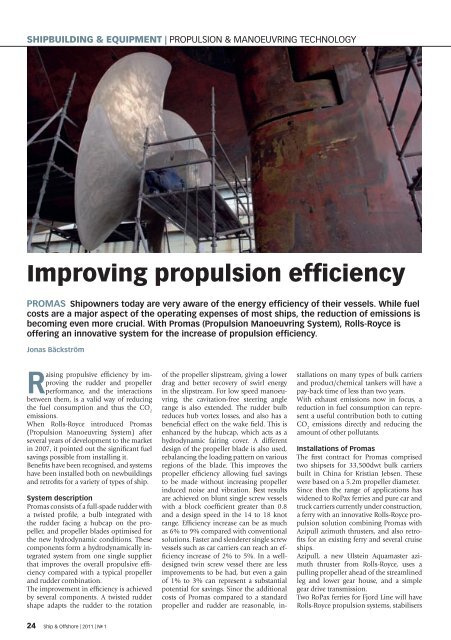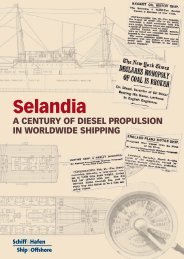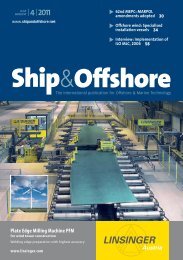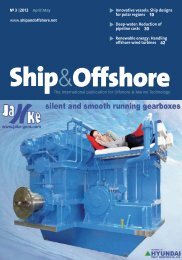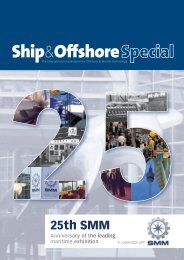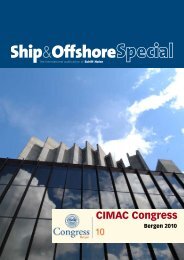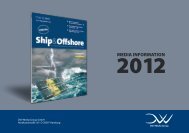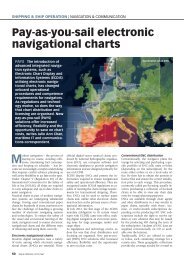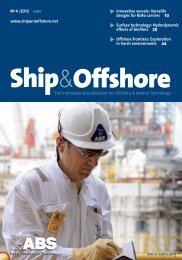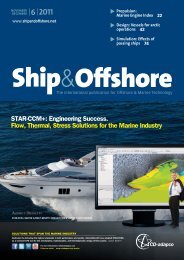Arctic technology: Winterisation of FPSO 38 Cruise ... - Ship & Offshore
Arctic technology: Winterisation of FPSO 38 Cruise ... - Ship & Offshore
Arctic technology: Winterisation of FPSO 38 Cruise ... - Ship & Offshore
You also want an ePaper? Increase the reach of your titles
YUMPU automatically turns print PDFs into web optimized ePapers that Google loves.
SHIPBUILDING & EQUIPMENT | PROPULSION & MANOEUVRING TECHNOLOGY<br />
Improving propulsion effi ciency<br />
PROMAS <strong>Ship</strong>owners today are very aware <strong>of</strong> the energy effi ciency <strong>of</strong> their vessels. While fuel<br />
costs are a major aspect <strong>of</strong> the operating expenses <strong>of</strong> most ships, the reduction <strong>of</strong> emissions is<br />
becoming even more crucial. With Promas (Propulsion Manoeuvring System), Rolls-Royce is<br />
<strong>of</strong>fering an innovative system for the increase <strong>of</strong> propulsion effi ciency.<br />
Jonas Bäckström<br />
Raising propulsive effi ciency by improving<br />
the rudder and propeller<br />
performance, and the interactions<br />
between them, is a valid way <strong>of</strong> reducing<br />
the fuel consumption and thus the CO 2<br />
emissions.<br />
When Rolls-Royce introduced Promas<br />
(Propulsion Manoeuvring System) after<br />
several years <strong>of</strong> development to the market<br />
in 2007, it pointed out the signifi cant fuel<br />
savings possible from installing it.<br />
Benefi ts have been recognised, and systems<br />
have been installed both on newbuildings<br />
and retr<strong>of</strong>i ts for a variety <strong>of</strong> types <strong>of</strong> ship.<br />
System description<br />
Promas consists <strong>of</strong> a full-spade rudder with<br />
a twisted pr<strong>of</strong>i le, a bulb integrated with<br />
the rudder facing a hubcap on the propeller,<br />
and propeller blades optimised for<br />
the new hydrodynamic conditions. These<br />
components form a hydrodynamically integrated<br />
system from one single supplier<br />
that improves the overall propulsive effi -<br />
ciency compared with a typical propeller<br />
and rudder combination.<br />
The improvement in effi ciency is achieved<br />
by several components. A twisted rudder<br />
shape adapts the rudder to the rotation<br />
24 <strong>Ship</strong> & <strong>Offshore</strong> | 2011 | N o 1<br />
<strong>of</strong> the propeller slipstream, giving a lower<br />
drag and better recovery <strong>of</strong> swirl energy<br />
in the slipstream. For low speed manoeuvring,<br />
the cavitation-free steering angle<br />
range is also extended. The rudder bulb<br />
reduces hub vortex losses, and also has a<br />
benefi cial effect on the wake fi eld. This is<br />
enhanced by the hubcap, which acts as a<br />
hydrodynamic fairing cover. A different<br />
design <strong>of</strong> the propeller blade is also used,<br />
rebalancing the loading pattern on various<br />
regions <strong>of</strong> the blade. This improves the<br />
propeller effi ciency allowing fuel savings<br />
to be made without increasing propeller<br />
induced noise and vibration. Best results<br />
are achieved on blunt single screw vessels<br />
with a block coeffi cient greater than 0.8<br />
and a design speed in the 14 to 18 knot<br />
range. Effi ciency increase can be as much<br />
as 6% to 9% compared with conventional<br />
solutions. Faster and slenderer single screw<br />
vessels such as car carriers can reach an effi<br />
ciency increase <strong>of</strong> 2% to 5%. In a welldesigned<br />
twin screw vessel there are less<br />
improvements to be had, but even a gain<br />
<strong>of</strong> 1% to 3% can represent a substantial<br />
potential for savings. Since the additional<br />
costs <strong>of</strong> Promas compared to a standard<br />
propeller and rudder are reasonable, in-<br />
stallations on many types <strong>of</strong> bulk carriers<br />
and product/chemical tankers will have a<br />
pay-back time <strong>of</strong> less than two years.<br />
With exhaust emissions now in focus, a<br />
reduction in fuel consumption can represent<br />
a useful contribution both to cutting<br />
CO 2 emissions directly and reducing the<br />
amount <strong>of</strong> other pollutants.<br />
Installations <strong>of</strong> Promas<br />
The fi rst contract for Promas comprised<br />
two shipsets for 33,500dwt bulk carriers<br />
built in China for Kristian Jebsen. These<br />
were based on a 5.2m propeller diameter.<br />
Since then the range <strong>of</strong> applications has<br />
widened to RoPax ferries and pure car and<br />
truck carriers currently under construction,<br />
a ferry with an innovative Rolls-Royce propulsion<br />
solution combining Promas with<br />
Azipull azimuth thrusters, and also retr<strong>of</strong>i<br />
ts for an existing ferry and several cruise<br />
ships.<br />
Azipull, a new Ulstein Aquamaster azimuth<br />
thruster from Rolls-Royce, uses a<br />
pulling propeller ahead <strong>of</strong> the streamlined<br />
leg and lower gear house, and a simple<br />
gear drive transmission.<br />
Two RoPax ferries for Fjord Line will have<br />
Rolls-Royce propulsion systems, stabilisers


